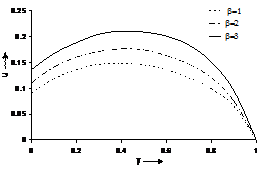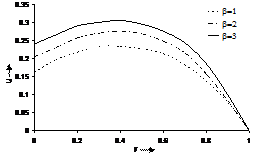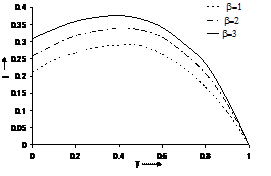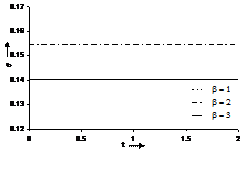 |
||||||
|
|
Home| Journals | Statistics Online Expert | About Us | Contact Us | |||||
 |
||||||
| About this Journal | Table of Contents | ||||||
|
|
[Abstract] [PDF] [HTML] [Linked References] Effects of Slip Condition on Unsteady MHD Oscillatory Flow of a Viscoelastic Fluid in a Planar Channel Utpal Jyoti Das Department of Mathematics, Rajiv Gandhi University, Itanagar-791112, Arunachal Pradesh, INDIA. Corresponding Addresses: Research Article
Abstract: An analytical study for unsteady magnetohydrodynamic oscillatory flow of an incompressible viscoelastic fluid in a planar channel filled with saturated porous medium is studied. It is assumed that the no-slip condition between the wall and the fluid remains no longer valid. The effect of the wall slip on velocity field and shear stress are illustrated graphically and physical aspects of the problem are discussed. 2000 Mathematics Subject Classification: 76A05, 76A10. Keywords: MHD, visco-elastic, radiation effect, heat transfer, porous channel, slip condition.
There are many significant differences between fluid flow at macro scale and that at micro/nano scale, e.g., wall-slip phenomena. Effects of slip conditions are very important for some fluids that exhibit wall slip. Fluids exhibiting slip are important in technological applications such as in the polishing of artificial heart valves, internal cavities and polymer melts. Therefore, the better understanding of the slip phenomena is necessary. Navier’s [1] proposed condition assumes that the velocity, where With a hot-wire anemometer Watanabe et al. [2-3] identify fluid slip at the wall of a strongly hydrophobic duct or pipe. Their velocity profiles are consistent with Navier’s hypothesis. Ruckenstein and Rajora [4] investigated fluid slip in glass capillaries with surfaces made repellent to the flowing liquid. Their experimental results of pressure drop indicate larger slip than that predicted by chemical potential theory, where slip is proportional to the gradient in the chemical potential. Mooney [5] studied the boundary layer flows with partial slip. Many researchers [6–7] had confirmed the phenomena of wall-slip fluids. The effect of slip condition on MHD steady flow in a channel with permeable boundaries has been discussed by Makinde and Osalusi [8]. Mehmood and Ali [9] studied the effect of wall slip on oscillatory flow of a viscous fluid in a planar channel. The stagnation slip flows on a fixed plate and on a moving one were considered by wang [10–11]. Hayat et al. [12] examined the effects of slip boundary conditions on fluid flow in a channel. The non-Newtonian flows with wall slip have been numerically studied in [13- 14]. The purpose of this study is to extend the work of Choudhury and Das [15] by considering the fluid slip at the lower wall. It is noted that our present solution reduces to the Choudhury and Das results by taking the slip velocity equal to zero.
Consider an incompressible flow of a conducting optically thin fluid bounded by two parallel plates separated by a distance a. The channel is assumed to be filled with a saturated porous medium. A uniform magnetic field of strength The dimensionless governing Eqns. together with the appropriate boundary conditions (neglecting the bars for clarity) can be written as
where
For purely an oscillatory flow, let
where
Substituting the above expressions into the Eqns. (1) and (2) and using the boundary condition (3), we get
subject to boundary conditions
where dash
Solving equation (6), we get
Substituting equation (8) in equation (5), and then solving it, we get
where
and
The purpose of this study is to bring out the result of physical impact of the slip with various combination of the viscoelastic parameter. For numerical validation of our analytical results, we have taken the real parts of the results throughout. In figures 1-3 we have plotted the velocity
Fig 1: Variation of
Fig 2: Variation of
Fig 3: Variation of
The non-dimensional shear stress
The figure 4 exhibits the effects of the shear stress
Fig 4: Variation of From the figure 4, it is observed that the shear stress decrease with the increasing values of the slip at the wall. References
|
|||||
|
||||||





